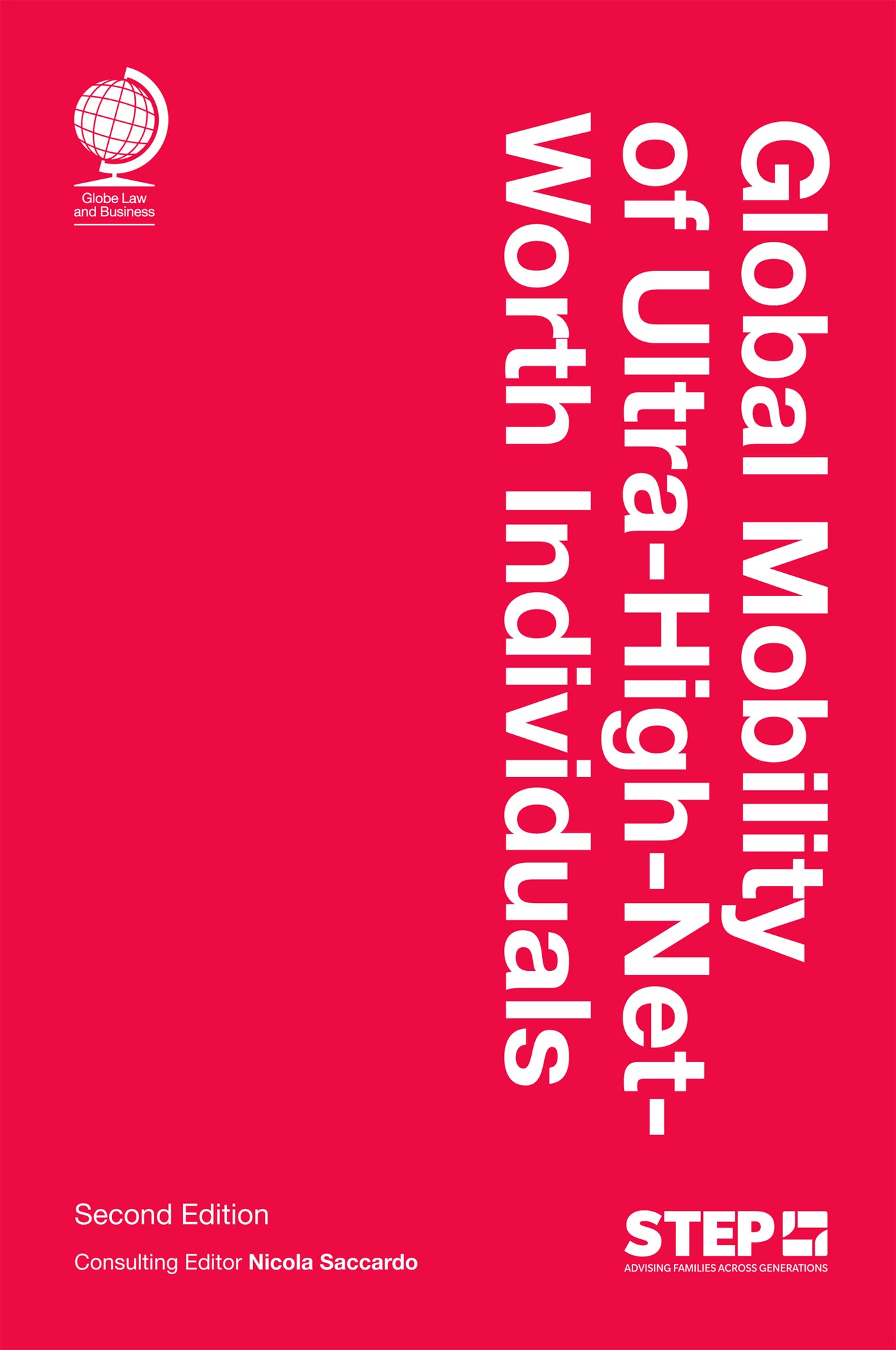We're sorry. An error has occurred
Please cancel or retry.
Global Mobility of Ultra-High-Net-Worth Individuals, Second edition
Regular price
£275.00
Sale price
£275.00
Regular price
£275.00
Unit price
/
per
Sale
Sold out
Only -12 units left
Co-published with STEP, this comprehensive new edition features insights from leading private client advisers across key jurisdictions worldwide.

Some error occured while loading the Quick View. Please close the Quick View and try reloading the page.
Couldn't load pickup availability
- Format:
-
08 July 2025

With increasing political uncertainty, evolving tax landscapes and the proliferation of special tax regimes designed to attract the wealthy, international relocation of ultra-high-net-worth individuals (UHNWIs) becomes more common. Advisers must take a holistic approach to guide clients through the complex legal and tax implications of cross-border moves.
Co-published with STEP, this comprehensive new edition features insights from leading private client advisers across key jurisdictions worldwide. It provides expert analysis of the legal and tax considerations involved in inbound and outbound relocations of UHNWIs, covering critical aspects such as:
• immigration: residency and citizenship pathways;
• taxation: impact of relocation on personal and business taxation;
• succession: estate planning and inheritance rules; and
• family law: implications for marital property, divorce and children.
This new edition includes 24 country-specific chapters, with new chapters featured including Brazil, the Cayman Islands, Jersey, Malta, Mexico and the United Arab Emirates. In addition, specialised chapters address broader international issues, including succession and family law issues triggered by relocation, the ramifications of moving works of art, fiscal nomads and the practical issues faced by trustees on the relocation of trust-related parties.
Designed for lawyers, bankers, tax advisers and all professionals working with UHNWIs, this book serves as an essential reference for navigating the legal and financial complexities of international residence planning.

Price: £275.00
Pages: 511
Publisher: Globe Law and Business
Imprint: Globe Law and Business
Publication Date:
08 July 2025
Trim Size: 9.50 X 6.25 in
ISBN: 9781837230761
Format: Hardcover
BISACs:
LAW, Legal Profession, Law, Company, commercial & competition law: general

The world is getting richer. According to Henley & Partners’ Centi-millionaires Report, as of mid-2023 there were some 28,420 centi-millionaires in the world, that is individuals whose assets exceed $100 mn. By now there are no doubt more. That number includes of course 2,350 billionaires. And let’s not forget the merely wealthy, UHNW individuals whose assets exceed $30 mn. Real estate agents Douglas Elliman [New York-based] and Knight Frank in London team up annually to produce a Wealth Report. The 2024 edition estimates the global number of UHNWIs at almost 600,000. That may be a tiny fraction of the world’s population, but is it still an awful lot of people.
What has driven this explosion of wealth is in part asset inflation, especially of property, but is mainly the result of globalisation: of markets, of brands, of supply chains, and of consumer purchasing habits. With all that has come mobility of residency and nationality. The wealthy are, in effect, global citizens. Take the case of the Mittal family, owners of the world’s second-biggest producer of steel, Arcelor Mittal. The firm is headquartered in Luxembourg, but employs 100,000 people worldwide. The public record tells us that the founder and current Chairman, Lakshmi Mittal, was born an Indian citizen and has become a British national, at time of writing resident in the UK. Second-generation CEO Aditya Mittal was born in Indonesia, educated there and in England and the United States. He has Indian citizenship. Many such families, whose wealth derives ultimately from enterprises they control, will move across the world as the stages of family life dictate: educating their children at secondary schools in the UK, for example, and at elite universities in the United States. Add in multiple home ownership in multiple jurisdictions, and the need for highly-skilled professional advice is more pressing than ever.
So the issue of this second edition of Global Mobility of Ultra-High-Net-Worth Individuals is well-timed. The volume divides usefully into two sections. In the first are 24 country profiles, across Europe, North and South America, the Middle East and Asia-Pacific. Each one is compiled by legal specialists in their fields. They cover in great detail critical aspects of residency across each jurisdiction and reveal the traps that await the unwary and unprepared. Do not assume, for instance, that the trusts or tax planning created in the United States will hold up under French law and against the challenges of the Direction Générale des Finances Publiques (DGFIP). Or that the Swiss laws on taxation are uniform: in that country’s robust tradition of devolved democracy, taxation is in part a matter for each canton. It may make a material difference whether you are based in Zurich or Zug.
The second part of this volume is grouped by topic, and different national regimes are compared and contrasted as they affect the natural concerns of the wealthy. Thus succession is discussed at length, and the pros and cons of residence by varying jurisdiction. This is of primary importance to both family businesses and business families, whose current wealth is diversified across multiple asset classes. Numerous countries are now setting out their stalls to attract the UHNW population, while others, such as the current UK government, seem to be doing their level best to drive them away. This book is an excellent point at which to start assessing the available options, and will serve both practitioners and their clients alike.
About STEP 7
Introduction 9
Nicola Saccardo
Charles Russell Speechlys
Part I. Jurisdictions
Australia 11
Daniel Appleby
Speed and Stracey Lawyers
Belgium 31
Dominique De Bie
Gerd D Goyvaerts
Tiberghien
Brazil 49
Alessandro Amadeu da Fonseca
Mattos Filho
Canada 63
Elie S Roth
Ryan Wolfe
Davies Ward Phillips & Vineberg LLP
Cayman Islands 91
Daniel Altneu
Bedell Cristin
China 113
Sakura Ji
Peter Ni
Zhong Lun Law Firm
France 127
Stéphanie Auféril
Arkwood SCP
Claire Brisset
Alta Avocat
Germany 141
Christian von Oertzen
Philipp Windeknecht
Flick Gocke Schaumburg
Greece 155
Elina Filippou
Nikos Maltezos
Despina Mourouti
Zepos & Yannopoulos
Guernsey 177
Matt Guthrie
Ogier (Guernsey) LLP
Hong Kong 187
Clifford Ng
Hilary Tai
Sanlie Yeung
Zhong Lun Law Firm LLP
India 199
Kunal Savani
Rishabh Shroff
Cyril Amarchand Mangaldas
Italy 221
Nicola Saccardo
Charles Russell Speechlys
Jersey 237
Jonathan Hughes
Ogier (Jersey) LLP
Malta 247
Rosanne Bonnici
Rebecca Diacono
Fenech & Fenech Advocates
Mexico 261
Samy Lazarov Schipper
Ana Sofía Ríos Artigas
Miguel Valle Salinas
Chevez Ruiz Zamarripa
Monaco 275
Xavier de Sarrau
Corinne Ricciardella
Gordon S Blair Law Offices
Portugal 285
Maria Inês Assis
Nuno Cunha Barnabé
Abreu Advogados
Singapore 309
Terre Chua
Wei Lun Gan
Vikna Rajah
Rajah & Tann Singapore LLP
Spain 321
Florentino Carreño
Cuatrecasas
Switzerland 337
Guillaume Grisel
Schellenberg Wittmer
United Arab Emirates 353
Donatello Pirlo
Carlo Stefano Rota
Statura
United Kingdom 373
Dominic Lawrance
James Riby
Kelvin Tanner
Charles Russell Speechlys
United States 397
Dean C Berry
William S Schaaf
Cadwalader, Wickersham & Taft LLP
Part II. General topics
The succession law ramifications of relocation 423
Richard Frimston
Andrew Godfrey
Russell-Cooke LLP
Relocation – planning to avoid the pitfalls of divorce 441
Rachael Burton
Mark Harper
Hughes Fowler Carruthers
Relocation and works of art 455
Ruth Cornett
Christie’s
Fiscal nomads: the impact of relocation on CRS and DAC6 469
Samantha Morgan
RMW Law LLP
John Riches
RMW Law LLP; Withers LLP
Naomi Shelton
RMW Law LLP
Practical issues faced by trustees on relocation of trust-related parties 483
Pedro Gemal
Anna Steward
Sequent
About the authors
About Globe Law and Business



